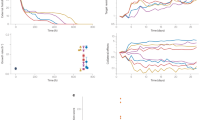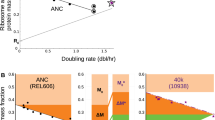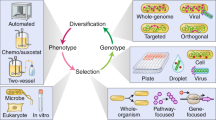Abstract
The pace and unpredictability of evolution are critically relevant in a variety of modern challenges, such as combating drug resistance in pathogens and cancer, understanding how species respond to environmental perturbations like climate change and developing artificial selection approaches for agriculture. Great progress has been made in quantitative modelling of evolution using fitness landscapes, allowing a degree of prediction for future evolutionary histories. Yet fine-grained control of the speed and distributions of these trajectories remains elusive. We propose an approach to achieve this using ideas originally developed in a completely different context—counterdiabatic driving to control the behaviour of quantum states for applications like quantum computing and manipulating ultracold atoms. Implementing these ideas for the first time in a biological context, we show how a set of external control parameters (that is, varying drug concentrations and types, temperature and nutrients) can guide the probability distribution of genotypes in a population along a specified path and time interval. This level of control, allowing empirical optimization of evolutionary speed and trajectories, has myriad potential applications, from enhancing adaptive therapies for diseases to the development of thermotolerant crops in preparation for climate change, to accelerating bioengineering methods built on evolutionary models, like directed evolution of biomolecules.
This is a preview of subscription content, access via your institution
Access options
Access Nature and 54 other Nature Portfolio journals
Get Nature+, our best-value online-access subscription
$29.99 / 30 days
cancel any time
Subscribe to this journal
Receive 12 print issues and online access
$259.00 per year
only $21.58 per issue
Buy this article
- Purchase on SpringerLink
- Instant access to full article PDF
Prices may be subject to local taxes which are calculated during checkout



Similar content being viewed by others
Data availability
The raw numerical data for the figures in the main text and Supplementary Information, as well as the code to generate the figures, are available via GitHub at https://github.com/Peyara/Evolution-Counterdiabatic-Driving. Source Data are provided with this paper.
Code availability
The code to perform the numerical simulations and the specific driving protocols is available via GitHub at https://github.com/Peyara/Evolution-Counterdiabatic-Driving.
References
Mira, P. M. et al. Rational design of antibiotic treatment plans: a treatment strategy for managing evolution and reversing resistance. PloS ONE 10, e0122283 (2015).
Ogbunugafor, C. B., Wylie, C. S., Diakite, I., Weinreich, D. M. & Hartl, D. L. Adaptive landscape by environment interactions dictate evolutionary dynamics in models of drug resistance. PLoS Comput. Biol. 12, e1004710 (2016).
Brown, K. M. et al. Compensatory mutations restore fitness during the evolution of dihydrofolate reductase. Mol. Biol. Evol. 27, 2682–2690 (2010).
Antimicrobial Resistance: Global Report on Surveillance (WHO, 2014).
Holohan, C., Van Schaeybroeck, S., Longley, D. B. & Johnston, P. G. Cancer drug resistance: an evolving paradigm. Nat. Rev. Cancer 13, 714–726 (2013).
Nichol, D. et al. Steering evolution with sequential therapy to prevent the emergence of bacterial antibiotic resistance. PLoS Comput. Biol. 11, e1004493 (2015).
Maltas, J. & Wood, K. B. Pervasive and diverse collateral sensitivity profiles inform optimal strategies to limit antibiotic resistance. PLoS Biol. 17, e3000515 (2019).
Bason, M. G. et al. High-fidelity quantum driving. Nat. Phys. 8, 147–152 (2012).
Zhou, B. B. et al. Accelerated quantum control using superadiabatic dynamics in a solid-state lambda system. Nat. Phys. 13, 330–334 (2017).
Walther, A. et al. Controlling fast transport of cold trapped ions. Phys. Rev. Lett. 109, 080501 (2012).
Farhi, E. et al. A quantum adiabatic evolution algorithm applied to random instances of an NP-complete problem. Science 292, 472–475 (2001).
Torrontegui, E. et al. Shortcuts to adiabaticity. Adv. At. Mol. Opt. Phys 62, 117–169 (2013).
Deffner, S., Jarzynski, C. & del Campo, A. Classical and quantum shortcuts to adiabaticity for scale-invariant driving. Phys. Rev. X 4, 021013 (2014).
Deffner, S. Shortcuts to adiabaticity: suppression of pair production in driven Dirac dynamics. New J. Phys. 18, 012001 (2015).
Acconcia, T. V., Bonança, M. V. S. & Deffner, S. Shortcuts to adiabaticity from linear response theory. Phys. Rev. E 92, 042148 (2015).
Campbell, S. & Deffner, S. Trade-off between speed and cost in shortcuts to adiabaticity. Phys. Rev. Lett. 118, 100601 (2017).
Guéry-Odelin, D. et al. Shortcuts to adiabaticity: concepts, methods and applications. Rev. Mod. Phys. 91, 045001 (2019).
Demirplak, M. & Rice, S. A. Adiabatic population transfer with control fields. J. Phys. Chem. A 107, 9937–9945 (2003).
Demirplak, M. & Rice, S. A. Assisted adiabatic passage revisited. J. Phys. Chem. B 109, 6838–6844 (2005).
Berry, M. V. Transitionless quantum driving. J. Phys. A Math. Theory 42, 365303 (2009).
Patra, A. & Jarzynski, C. Shortcuts to adiabaticity using flow fields. New J. Phys. 19, 125009 (2017).
Li, G., Quan, H. & Tu, Z. Shortcuts to isothermality and nonequilibrium work relations. Phys. Rev. E 96, 012144 (2017).
Martínez, I. A., Petrosyan, A., Guéry-Odelin, D., Trizac, E. & Ciliberto, S. Engineered swift equilibration of a Brownian particle. Nat. Phys. 12, 843–846 (2016).
Le Cunuder, A. et al. Fast equilibrium switch of a micro mechanical oscillator. Appl. Phys. Lett. 109, 113502 (2016).
Schmiedl, T. & Seifert, U. Optimal finite-time processes in stochastic thermodynamics. Phys. Rev. Lett. 98, 108301 (2007).
Aurell, E., Gawędzki, K., Mejía-Monasterio, C., Mohayaee, R. & Muratore-Ginanneschi, P. Refined second law of thermodynamics for fast random processes. J. Stat. Phys. 147, 487–505 (2012).
Wright, S. The roles of mutation, inbreeding, crossbreeding and selection in evolution. In Proc. Sixth Int. Congress on Genetics Vol. 1, 356–366 (Univ. Chicago Press, 1932).
Mustonen, V. & Lässig, M. Fitness flux and ubiquity of adaptive evolution. Proc. Natl Acad. Sci. USA 107, 4248–4253 (2010).
Grabert, H., Hänggi, P. & Talkner, P. Is quantum mechanics equivalent to a classical stochastic process? Phys. Rev. A 19, 2440–2445 (1979).
Van Kampen, N. G. Stochastic Processes in Physics and Chemistry (Elsevier, 1992).
Risken, H. The Fokker-Planck Equation (Springer, 1996).
Born, M. & Fock, V. Beweis des Adiabatensatzes. Z. Phys. 51, 165–180 (1928).
Nichol, D. et al. Antibiotic collateral sensitivity is contingent on the repeatability of evolution. Nat. Commun. 10, 334 (2019).
Li, Y., Petrov, D. A. & Sherlock, G. Single nucleotide mapping of trait space reveals Pareto fronts that constrain adaptation. Nat. Ecol. Evol 3, 1539–1551 (2019).
Vaikuntanathan, S. & Jarzynski, C. Dissipation and lag in irreversible processes. Europhys. Lett. 87, 60005 (2009).
Gillespie, J. H. A simple stochastic gene substitution model. Theor. Popul. Biol. 23, 202–215 (1983).
Gerrish, P. J. & Lenski, R. E. The fate of competing beneficial mutations in an asexual population. Genetica 102, 127 (1998).
Desai, M. M. & Fisher, D. S. Beneficial mutation–selection balance and the effect of linkage on positive selection. Genetics 176, 1759–1798 (2007).
Sniegowski, P. D. & Gerrish, P. J. Beneficial mutations and the dynamics of adaptation in asexual populations. Philos. Trans. R. Soc. B 365, 1255–1263 (2010).
Martens, E. A. & Hallatschek, O. Interfering waves of adaptation promote spatial mixing. Genetics 189, 1045–1060 (2011).
Magdanova, L. & Golyasnaya, N. Heterogeneity as an adaptive trait of microbial populations. Microbiology 82, 1–10 (2013).
Krishnan, N. & Scott, J. G. Range expansion shifts clonal interference patterns in evolving populations. Preprint at https://www.biorxiv.org/content/10.1101/794867v2 (2019).
Sella, G. & Hirsh, A. E. The application of statistical physics to evolutionary biology. Proc. Natl Acad. Sci. USA 102, 9541–9546 (2005).
Kullback, S. & Leibler, R. A. On information and sufficiency. Ann. Math. Stat. 22, 79–86 (1951).
Kaznatcheev, A. Computational complexity as an ultimate constraint on evolution. Genetics 212, 245–265 (2019).
Baxter, G. J., Blythe, R. A. & McKane, A. J. Exact solution of the multi-allelic diffusion model. Math. Biosci. 209, 124–170 (2007).
Kimura, M. Stochastic processes and distribution of gene frequencies under natural selection. Cold Spring Harb. Symp. Quant. Biol. 20, 33–53 (1955).
Gillespie, D. T. The multivariate Langevin and Fokker–Planck equations. Am. J. Phys. 64, 1246–1257 (1996).
Sahoo, S. Inverse vector operators. Preprint at https://arxiv.org/pdf/0804.2239.pdf (2008).
Gillespie, D. T. The chemical Langevin equation. J. Chem. Phys. 113, 297–306 (2000).
Acknowledgements
M.H. thanks the US National Science Foundation for support through a CAREER grant (BIO/MCB 1651560). J.G.S. thanks the NIH Loan Repayment Program for their generous support and the Paul Calabresi Career Development Award for Clinical Oncology (NIH K12CA076917). S.D. acknowledges support from the US National Science Foundation under grant no. CHE-1648973. E.I. acknowledges support from Labex CelTisPhyBio (ANR-11-LABX-0038, ANR-10-IDEX-0001-02).
Author information
Authors and Affiliations
Contributions
S.I. and J.P. performed mathematical analysis, wrote the two-allele code, peformed simulations, analysed the data and wrote the manuscript. J.C., E.I., O.G., B.K.-S. performed mathematical analysis, analysed the data and wrote the manuscript. E.D. and N.K. wrote the multidimensional ABM code, performed the simulations, analysed data and wrote the manuscript. J.G.S. analysed the data and wrote the manuscript. M.H. performed the mathematical analysis and simulations, wrote code, analysed the data and wrote the manuscript. S.D. wrote the manuscript, and S.D., E.I., J.G.S. and M.H. contributed to developing the overall theoretical framework.
Corresponding authors
Ethics declarations
Competing interests
The authors declare no competing interests.
Additional information
Peer review information Nature Physics thanks Ken Funo and Daniel Weinreich for their contribution to the peer review of this work.
Publisher’s note Springer Nature remains neutral with regard to jurisdictional claims in published maps and institutional affiliations.
Extended data
Extended Data Fig. 1 CD driving for an altered 16-genotype pyrimethamine seascape.
This is the same seascape as in main text Fig. 3, using the experimental data of Ref. 2, except that genotype 0110 has been modified to have a 5% larger base growth rate under no drug conditions. a,b, Sample simulation trajectories (solid lines) versus IE expectation (dashed lines) for the fraction of 4 representative genotypes without a and with b CD driving. The CD driving is implemented approximately through the drug dosage protocol (green curve) shown in panel c with cutoff 10−2 M. The original protocol (blue curve) is shown for comparison. d, Kullback–Leibler divergence between actual and IE distributions versus time, with and without CD driving.
Extended Data Fig. 2 CD driving for a 16-genotype cycloguanil seascape.
This is the same 16-genotype system as in the examples of main text Fig. 3 and Extended Data Fig. 1, except using the antimalarial drug cycloguanil instead of pyrimethamine. The seascape is based on the experimental data of Ref. 2, without any modifications. a,b, Sample simulation trajectories (solid lines) versus IE expectation (dashed lines) for the fraction of 4 representative genotypes without a and with b CD driving. The CD driving is implemented approximately through the drug dosage protocol (green curve) shown in panel c. The original protocol (blue curve) is shown for comparison. d, Kullback–Leibler divergence between actual and IE distributions versus time, with and without CD driving.
Supplementary information
Supplementary Information
Supplementary Discussion and Figs. 1–4.
Rights and permissions
About this article
Cite this article
Iram, S., Dolson, E., Chiel, J. et al. Controlling the speed and trajectory of evolution with counterdiabatic driving. Nat. Phys. 17, 135–142 (2021). https://doi.org/10.1038/s41567-020-0989-3
Received:
Accepted:
Published:
Issue Date:
DOI: https://doi.org/10.1038/s41567-020-0989-3



